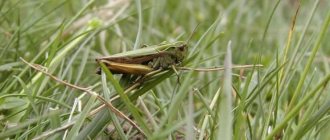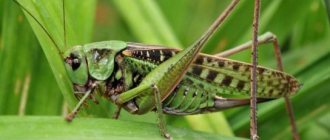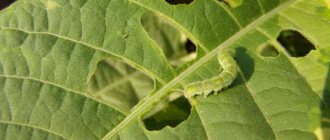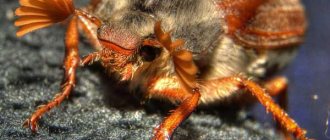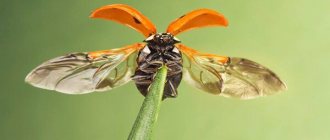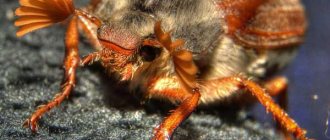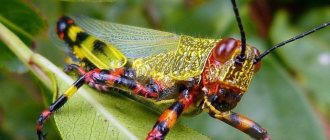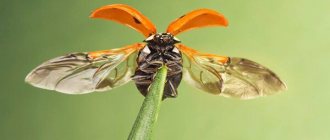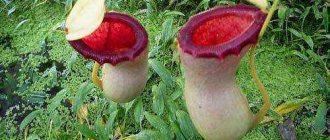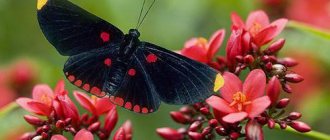Every child, starting in kindergarten, knows what a grasshopper looks like. But this stereotype is very misleading. There are more than 6 thousand species of grasshoppers and they look completely different. Some are similar to those depicted in children's books, others to those shown in horror films. There are even some that are indistinguishable from real leaves and have an incredible level of stealth. Grasshoppers live in a variety of places and can be found on almost all continents except Antarctica.
We invite you to get acquainted with the largest representatives of grasshoppers in the world, which can reach up to 15 centimeters in length. But with all this, even the largest grasshoppers do not look intimidating, and some are even kept at home.
Green grasshopper, 36 mm
Adult green grasshoppers can reach 28-36 mm in length. Although this is an average size of insects, among grasshoppers this species is included in the list of the largest.
They prefer to live in wet meadows, swamps, grassy thickets and forest edges. They feed mainly on other small insects. If they cannot catch such delicacies, they consume leaves, buds and flowers in large quantities. Cannibalism is sometimes observed.
There are no special features in the structure. They can be bright green or yellowish. This is exactly the familiar look that everyone knows, from young to old. Most often, these are the grasshoppers that are drawn in the encyclopedia for reference.
Cave grasshoppers (family)
Representatives of this family, like grasshoppers, belong to the order Orthoptera. And it includes about five hundred species. Like the previously described members of the insect kingdom, these creatures are distributed in almost all areas of the planet that are at least somewhat suitable for life.
They are medium in size, equipped with sensitive antennae and long limbs. But they don't have wings. In addition, they are more characteristic of a twilight or nocturnal mode of existence rather than a daytime one. They live in dark, dense forests, mines and caves. Continuing to describe the types of grasshoppers , we will consider the following representatives of this family.
Greenhouse grasshopper
The variety received this name because insects of this type are often found in greenhouses. They also settle in the basements of homes. These are not very large creatures, but with very developed senses of touch. And it is not surprising, because they love the darkness and strive to hide from the light; it is natural that they should not see well.
That is, they need something else to perceive their surroundings. Therefore, their antennae can be up to 8 cm long. These insects are also characterized by a twisted, stocky body covered with hair. Their color can be gray or brown with a yellowish tint.
East Asia is considered their homeland, but such grasshoppers have long spread beyond these territories, reaching Europe and even America. For ornamental and tropical plants, they are pests that eat their succulent shoots.
Far Eastern grasshopper
Another lover of secluded places and darkness, related to the grasshoppers of caves, by the way, is found there quite often. Such insects also prefer to live in thickets of cedar forests, where they love to climb into animal burrows and other types of earthen depressions.
In other conditions, they hide from sunlight under stones and slabs, and crawl out in search of food only at night. The color of such creatures is inconspicuous, brown or gray, the size is less than 2 cm. According to the name, the homeland of such creatures is the Far East.
Grasshopper-leaf, 60 mm
This is an incredible insect that is very difficult to distinguish from a real leaf. It simulated not only color and shape, but even veins. For predators who want to feast on these insects, the task is almost impossible. He even disguised his paws, which look like dry twigs.
Of all the species of grasshoppers, and there are more than six thousand of them, this is perhaps one of the most unusual. The leaf grasshopper reaches 60 mm in length There are a lot of such subspecies with an incredible level of camouflage and they all reached this level through evolution.
Thick Pallas, 60 mm
The peculiarity of this grasshopper is very unusual; not only is it one of the largest, but it also cannot jump. It would seem that this is a distinctive feature of this type of insect, but Fat Pallas cannot raise his body high on such thin legs.
By the way, this is why he got his nickname and fully justifies it. Most often you can find them in Asia, but you can also see them in Russia. They are often kept at home. In the wild, they prefer plant foods, but they can also feast on the remains of other insects.
At home they are fed vegetables and fruits. The coloring is very interesting and not typical for grasshoppers. Dark brown with symmetrical light brown stripes. Everything about this insect is atypical for its fellows; it prefers to crawl away from danger rather than jump.
Top 10 largest insects in the world on Earth
On earth, more than 80% of species are occupied by insects. There are about 900,000 different insect species on Earth, and about a million are still waiting to be discovered. Most of them are very disgusting and scary, but they are a very important part of this environment.
The largest insects that ever lived on earth were dragonflies, similar to the Protodonata insects. They had wings almost 76 cm across and huge jaws, but they have been around for a long time. Here is a list of the world's 10 largest insects on Earth. This list contains the largest insect that exists on earth currently.
Tarantula Hawk
The Tarantula Hawk is popular because it hunts the tarantula as food for its larvae. They are primarily found in New Mexico. It is 2 inches long but has a 1/3 inch bite and is considered the second most painful insect sting in the world. It burns and paralyzes the spider and lays an egg on the spider's stomach.
Giant burrowing rhinoceros cockroach
The giant burrowing cockroach is also known as the rhinoceros cockroach and beetles. They are the heaviest cockroach species in the world and are mainly found in Australia and tropical Queensland. They can grow up to 35 grams in weight and 3.1 inches in length. They can live up to 10 years and can be identified by the scoop on their head, males have a scoop on their head but females do not.
Goliath beetle
The goliath beetle is one of the world's strongest contenders for the largest insects on earth. They are mainly found in Africa and can grow up to 4 inches in length and up to 100 cm in height. They feed mainly on tree sap and fruits. They are vegetarians and eat cat and dog food. The male is black and white in color and the female is dark brown or silky white in color.
Giant Weta
The Giant Weta is one of the heaviest insects in the world, found in New Zealand. They can grow up to 4 inches in length and typically weigh more than a sparrow. They are found only on islands and are known as island gigantism. They tend to be less social and more passive than other Weta.
Giant long-legged katydids
Giant long-legged katydids are the largest katydid species in the world. It belongs to the tettigoniidae family, which has almost 6,400 species and looks like grasshoppers and crickets. They can grow up to 6 inches in length. Their natural habitat includes the forests of Malaysia, where its leaf-like structure helps them hide from predators.
Giant camel spider
The giant camel spider is also known as the scorpion spider, sun spider or soliphugus. It has two markings and an abdominal cavity behind the prosoma, which combines the head and thorax. Most of the giant camel spider lives in dry climates and feeds on antipodes and small animals. They can grow up to 5-6 inches and are very fast on land compared to other invertebrates with a top speed of 10 mph.
Lumberjack Titan
The Titan beetle is a Neotropical longhorn beetle and the second largest known beetle. They can grow up to 7 inches in length. Their jaws can cut a pencil in two and tear human flesh. They are mainly found in the Amazon rainforest, but larvae have never been found. They are thought to feed inside the tree and may take several years to reach full size.
Peacock eye atlas
These bird-sized moths are considered to be the largest moths in the world. They are brown in color with triangular windows on both wings. In Southeast Asia, these moths are farmed for their silk, and their cocoons are sometimes used as purses in Taiwan. The largest moths have a wingspan of over 10 inches.
Queen Alexandra's Birdwing
Queen Alexandra's Birdwing is the largest butterfly in the world. Females can reach a wingspan of 12.2 inches, including a body length of 3.2 inches. Found only in Papua New Guinea. The female butterfly has brown wings with white markings, while the males are bluish-green with a black central stripe.
Giant stick insect
The giant stick insect is the longest insect on earth. It has a strange shape to hide itself from predators among the branches. The giant stick insect is found in Southeast Asia and is the longest insect, measuring about 2 feet in length. Some of these species may produce a pungent odor for protection, but they are harmless to humans.
Source: https://new-science.ru/top-10-samyh-bolshih-nasekomyh-v-mire-na-zemle/
Spiny devil, 70 mm
The appearance of this grasshopper is striking, but it is thanks to its unusual needles that it can protect itself. It received such a terrible name precisely because of its unusual and intimidating appearance.
It is completely covered with needles. If predators or birds try to get close to it, it begins to wave its front legs and threaten with sharp spines. You can meet him along the Amazon and listen to the serenades he sings throughout the night.
Spiny devils feed on plant foods, but are not averse to eating other insects. It reaches 70 mm in length and is enough to repel its opponents. Also, to scare off his opponents, he came up with a cunning plan. When he sees that a predator is approaching him, he sharply raises his hind legs, which are brightly colored, and while the predator comes to his senses, he quickly crawls away.
Structure
External characteristics of the grasshopper:
- Body flattened on both sides;
- Head with large eyes;
- 3 pairs of legs;
- Mustache;
- Wings.
They move with the help of their front legs, and with the help of their more muscular hind legs, insects jump quite long distances. The length of the jump is 20 times greater than the insect's body.
The length of a grasshopper depends on the species and ranges from 1 to 5 cm, but there are some individuals whose size reaches 15 cm. Which is comparable to the length of a praying mantis.
The whiskers serve as the insect's sense of touch. An interesting fact is that the longer the length of the antennae, the higher the higher place the grasshopper occupies on the hierarchical ladder among its relatives.
The wings have a direct function and help the grasshopper take off and fly short distances.
Some subspecies have an additional pair of wings that perform a protective or safety function for the main wings.
Mormon, 80 mm
The appearance of the grasshopper is no different from the usual ones. The only thing is that the body is more round and it looks very “well-fed”. It is classified as a pest, as it often spoils garden plants. It lives in North America closer to pastures in order to eat plants planted by humans.
Mormon in length , and combined with its volume, it looks very massive. It can cover distances of more than two kilometers per day, despite the fact that this species does not fly.
The largest insects in the world
There are so many varieties of insects on the planet that scientists cannot count them. It is believed that the Earth is inhabited by about 3 million species of these creatures. They all differ from each other in their lifestyle, body structure, role in the ecosystem, degree of danger to humans and size. The article presents the TOP 17 largest insects living in different parts of the planet.
Giant hornet
The giant hornet or Vespa mandarinia is a rare endemic found in China, Japan and India. The insect is less common in the mountainous areas of Sri Lanka. The giant hornet also lives in Russia, but only in the Primorsky Territory and near the Anyui River (Khabarovsk region).
The length of an adult individual exceeds 5 cm, and its wingspan reaches 75 mm.
The main distinguishing feature of Vespa mandarinia from other representatives of Hymenoptera is its large head and long sting. The Chinese and Japanese call this insect the “sparrow bee” or “tiger bee.” It is not advisable to contact it, as its bite can cause pain, local swelling and a severe allergic reaction.
Rhinoceros cockroach
Another name for the insect is the burrowing cockroach. The body length of females reaches 8 cm, and their weight ranges from 35-45 grams, which is equal to the mass of a small bird from the passerine family. Despite their name, rhinoceros cockroaches do not have horns, but they are quite nimble and active.
Insects spend most of their time searching for food (eucalyptus leaves, berries, fruits) and digging underground passages in which they lay eggs and raise offspring. Cubs of burrowing cockroaches live with their mother for 8-9 months, after which they begin to feed on their own and establish burrows in the ground.
The rhinoceros cockroach is the oldest representative of insects. Presumably, he appeared on Earth 300,000,000 years ago. It easily adapts to new conditions and is able to survive high levels of radiation. This was the reason why it did not become extinct.
Hercules beetle
A large beetle from the genus Dynastes, the distinctive feature of which is two huge horns. They function as a means of protection against natural enemies, help to dig in the ground and fight with rivals during the mating period. Hercules beetles live in the forests of Central and North America and the Caribbean islands.
The creature got its name due to the fact that it is capable of carrying objects that exceed its mass by 100 times. The beetle is also enormous in size. The length of females reaches 8 cm, and males grow up to 17.
Giant scolopendra
The giant scolopendra was nicknamed a fast killer with poisonous legs and was called the largest insect on the planet. She is a rather aggressive creature and often attacks first. Scolopendra inhabits the tropics of South America, feeding on lizards, small snakes, birds and frogs.
Occasionally eats plant foods or dives into the water for fish.
In addition to its length of 25-30 centimeters, the scolopendra became famous for its powerful legs, allowing it to jump great distances, and its fast-acting poison.
If a scolopendra bites a small animal, it will die in a matter of minutes. The person will not die from the poison, but will experience terrible pain, fever and severe swelling of the soft tissues.
Death can only occur if the victim has allergies.
Flowers you can and cannot keep at home
Queen Alexandra's Birdwing
A beautiful day butterfly from the Swallowtail family, found by the famous businessman and insect collector Walter Rothschild. He named the find in honor of the wife of the English monarch Edward VII. The birdwing is native to Papua New Guinea.
In the 20th century, a significant part of the butterfly population was destroyed by the Lamington volcano, which is why the species was listed as endangered in the Red Book. The largest insect of this species is kept in a London museum. The length of its abdomen is 80 mm, and the mass of a dried specimen exceeds 11 grams.
5. Pseudophyllinae, 80 mm
This is a subfamily of grasshoppers that can reach a length of 30 to 80 mm. The appearance resembles leaves, including veins, twigs and even brown spots. It is almost impossible to distinguish them on the ground from real leaves. One can only envy such camouflage, because not every insect can camouflage itself from predators like Pseudophyllinae .
Notes
- Kharkova O. Yu.
Red Book. Butterflies, beetles and other insects - M.: Eksmo, 2015. - Steele F.
Atlas of the World for Schoolchildren - M.: Olma-press, 2006. - ISBN 5-94847-006-7. - ↑ 12
New Zealand ecology. Gigantism in insects publisher = TerraNature Trust (English). Access date: April 2, 2010. Archived April 21, 2012. - ↑ 12
Did You Know that Hauturu is…. (English) (inaccessible link). Little Barrier Island (Hauturu) Trus. Access date: April 2, 2010. Archived April 21, 2012. - Bandwhiskers (Scarabaeidae)
- ↑ 12
The University of Florida Book of Insect Records - Chapter 30: Largest - Ronald M. Young - A Field Guide to the Dynastidae Family of the South of South America, Absaroka Natural History Trust, 1526 Beck Avenue, Cody,
Original: Original:
Giant Hueta, 100 mm
This species can be found in New Zealand. It reaches 100 mm in length and weighs more than 70 g. Such volumes make it very impressive and even intimidating. In the movie “King Kong” these particular grasshoppers were increased in size in the frames.
Of all insects, the Giant Weta ranks first in terms of weight. The paws are equipped with spikes, which adds even more creepiness. They live not only in forests, but also in open areas, in caves and even in cities. They are considered living fossils due to their long existence.
This type of grasshopper is listed in the Guinness Book of Records; there are not very many of them left and numerous rodents influenced this. Ueta is the collective name for insects from the order Orthoptera. All of them belong to two families and live in the New Zealand archipelago and adjacent islands.
Top 10 largest insects in the world
There are no more mysterious creatures on the planet than insects. Their appearance is striking and evokes thoughts of extraterrestrial origin. Our Top 10 today contains the largest insects in the world .
Such a company may scare some people, while others will arouse a lot of curiosity. But definitely no one will remain indifferent when they see a twenty-centimeter beetle. By the way, according to many scientists, the discovery of species previously unknown to science is most likely among insects. So it is quite possible that our current top ten will be replenished with new participants in the very near future.
Giant weta (Deinacrida heteracantha)
Giant stag beetle (Lucanus elaphus).
Goliath beetles (Goliathus)
Giant stick insect (Dryococelus australis)
Queen Alexandra Bird Wing
- the largest butterfly in the world . The wingspan of the female reaches 35 cm. This species lives in Papua New Guinea. The survival of the offspring is ensured in a very unusual way - the caterpillars of this species are inedible for predators, since the butterflies feed on the poisonous pollen of the Aristolochia schlecteri plant.
Dung beetle (Geotrupidae)
Giant water bug (Belostomatidae)
Peacock Butterfly (Attacus atlas)
It has an impressive wingspan - up to 26 cm. The beautiful red-brown color in combination with white “eyes” looks very elegant and makes it the most beautiful butterfly in the world.
Chan's megastick insect (Phobaeticus chani)
- the longest insect in the world . The length of the body, reminiscent of a dry branch, can reach 37 cm, and taking into account the legs - 56 cm. These insects live on the island of Kalimantan and are simply champions of camouflage - it is almost impossible to find a stick insect among the branches.
Titan Lumberjack (Titanus giganteus)
- the largest insect in the world. The body length of this beetle reaches 21 cm. The species is very rare, but lives in a vast territory of Peru, Ecuador, Colombia, Suriname, Guyana, Bolivia and Brazil.
Source: https://basetop.ru/top-10-samyih-bolshih-nasekomyih-v-mire/
Giant long-legged grasshopper, 100 mm
Perhaps this is another one of the most unusual insects in the whole world. When he sits in your arms, you can compare him in size to a small kitten. The total length reaches 100 mm, but due to its long legs it looks much larger. They can only be found in the mountains, not far from Malaysia. They are well camouflaged and look like green leaves.
Despite the length of its legs, the Giant Long-legged Grasshopper prefers to crawl rather than jump. It feeds on plants, but may also eat other insects. It is active at night and obtains food only in the light of the moon.
Titan lumberjack beetle
One of the largest and most mysterious insects. It hisses, bites, and does not pose a serious danger to humans unless it gets very angry. The beetle is called a woodcutter because:
- has powerful jaws and spiked claws on its paws, can bite through a branch as thick as a finger;
- its larvae live in tree bark and feed on its rotting parts.
The beetle's body size is equal to the length of the average man's palm. It is predominantly nocturnal and loves heat and humidity. The titan lumberjack is not easy to observe; it rarely shows itself to humans.
The titan woodcutter is the cherished dream of all collectors. Catching such an insect means success in business, because the price of a beetle ranges from $500 and above.
Steppe rack, 120 mm
This type of grasshopper can be found throughout most of Eurasia, but it is very difficult to spot it in its habitat. The steppe grasshopper prefers ravines and other hard-to-reach places.
It can be 120 mm in length, which makes it look very impressive. The color is green or slightly yellowish. It is most active at night; during the day it prefers to sit in tall grass and avoid predators.
Spider Theraphose Blonde
The Terafosa Blond spider (also known as the Goliath tarantula, or Goliath spider) is the world record holder for the largest spider. Its impressive size ( up to 30cm , including head, chest, abdomen and paws) allows it to hunt toads, snakes and lizards, and sometimes mice. But in addition to reptiles and small mammals, the spider can also eat a chick that has fallen out of the nest. Therefore it is called a tarantula.
Habitat: South America, swampy and marshy areas. The color is dark brown, the chitinous cuticle is covered with hairs, so it looks like velvet. But the hairs, in addition to being aesthetic, have a protective and tactile function: they cause irritation when they get on the mucous membranes and help the spider navigate in space. Despite its terrifying appearance, Theraphosa blondi is not dangerous to humans. The bite of a goliath tarantula is comparable to a bee sting.
Peacock grasshopper, 150 mm
This grasshopper has several names, but the most popular is peacock . It got its nickname because of its unusual appearance, which resembles a peacock's tail. This species was discovered quite recently, on an expedition in 2006.
He has two cunning defense plans. At first it looks like a fallen leaf, with its wings closed it is very difficult to distinguish. But if a predator approaches it, it opens its wings and begins to jump so that its eye patterns give the impression of a large bird.
The insect reaches a size of 150 mm and looks incredibly beautiful with open wings. Many butterflies use this pattern.
3 1
Amazing facts
Female Weta grasshoppers are heavier and larger than males. On average, the weight of females can reach up to 35 grams. This is even more than the average sparrow weighs!
Puberty in both females and males occurs at approximately 14-24 months. They begin to mate 1-2 months after maturity. During one mating, the female lays 10-300 eggs.
The subspecies' favorite diet is fresh leaves from local plants. For example, they love to eat the foliage of karaka, karama, mamanga, masho and koekohe. Until the moment of “coming of age,” each grasshopper goes through 11 periods of maturation. This means that he loses his external exoskeleton 11 times and acquires a new one.
